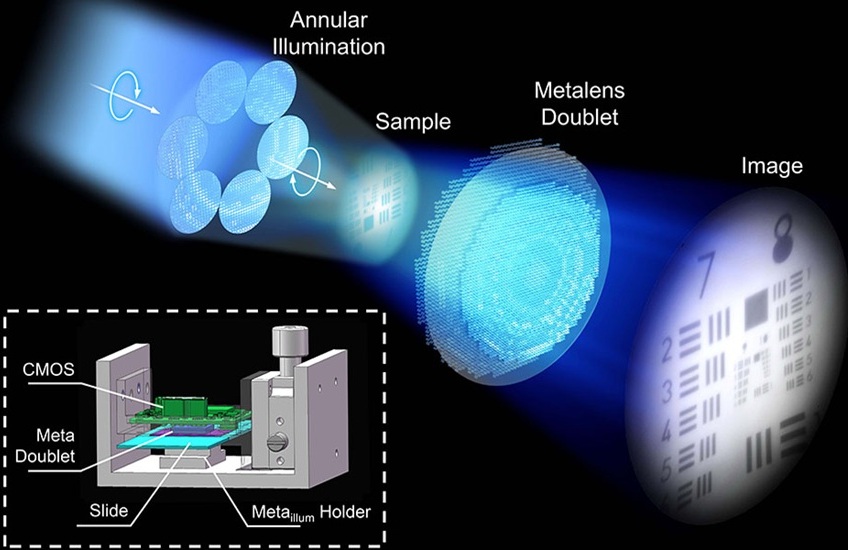High-Resolution Metalens Doublet Microscope to Enhance Diagnostic Capabilities
Posted on 30 May 2025
Metalenses mark a groundbreaking leap in optical technology. Unlike traditional microscope objectives that rely on curved glass surfaces, metalenses utilize nanoscale structures to manipulate light at a subwavelength level. Their ultrathin, lightweight, and flat design allows metalenses to overcome the bulkiness of conventional lenses, making them ideal for integration into electronic devices and compact imaging systems. However, despite their promising potential for next-generation optical technologies, metalenses face significant hurdles in practical microscopy applications. A key challenge is the presence of off-axis aberrations, which severely limit the field of view (FOV) and resolution of metalenses. The trade-off between resolution and FOV has thus far prevented metalenses from reaching the performance levels of traditional microscopes. While some earlier designs of metalenses have achieved submicron resolution, they typically have extremely restricted FOVs, limiting their practical application. Now, a new metalens doublet configuration combined with annular illumination can overcome these off-axis aberrations and deliver unprecedented high-resolution wide-field imaging, even in a compact and highly integrated prototype.
Researchers from Nanjing University (Nanjing, China) have introduced a breakthrough solution that significantly enhances metalens performance in microscopy. Their study, published in Advanced Photonics, presents a metalens-based microscope that offers both wide FOV and high-resolution imaging within a compact design. The researchers addressed the inherent limitations of metalenses by using a doublet configuration, consisting of two metalenses placed on opposite sides of a transparent silica substrate, combined with annular illumination. The two metalenses feature silicon nitride nano-fins, designed as high-aspect-ratio squares with precise dimensions, arranged at meticulously calculated intervals. This configuration effectively reduces off-axis aberrations and simultaneously enhances resolution, optimizing imaging performance. This achievement is a major breakthrough, as the researchers were able to resolve features that previous metalens systems could not detect.

To further validate the effectiveness of their approach, the team developed a highly compact prototype. The device achieved a remarkable 1 mm FOV and a half-pitch resolution of 620 nm. Notably, the design incorporated metasurfaces not only for imaging purposes but also to generate the annular illumination, further enhancing the system’s compactness. Measuring just 4 cm × 4 cm × 5 cm, the prototype is a thousand times smaller and lighter than standard microscopes. The researchers used their meta-microscope to image cervical cancer cells, successfully capturing images of various stages of cancer progression within the same FOV. This allowed the system to reveal important cellular features, including nuclear enlargement, deformation, and division. The ability to observe these details across a wide FOV provides medical professionals with a comprehensive view of tissue samples, potentially improving diagnostic accuracy.
This technology holds significant promise for applications requiring both portability and high-performance imaging. Potential use cases include biomedical imaging in resource-limited environments, mobile health monitoring, and outdoor research scenarios where traditional microscopes would be impractical. The potential for integration with microelectronic devices could also enable its use in emerging technologies, such as advanced clinical or biomedical automation systems. Overall, this development represents a major step forward in creating practical metalens-based imaging systems that can rival conventional optics, offering considerable advantages in terms of size, weight, and integration capabilities. This approach not only paves the way for more compact microscopes but also opens doors for the design of other high-performance meta-devices across various optical applications.
“Our metalens microscope, featuring a FOV of up to 150 μm and a half-pitch-resolution of 310 nm, far exceeds the highest resolution ever reported in meta-microscopy,” said corresponding author Dr. Tao Li. “Our experimental results demonstrate high-quality microscopic bioimages that are comparable to those obtained from traditional microscopes within a compact prototype, highlighting its potential applications in portable and convenient settings.”














